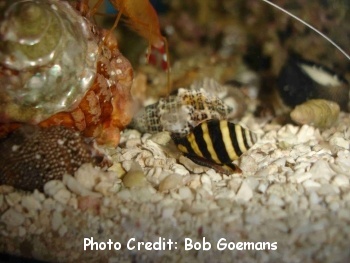
By Bob Goemans

Likely Reef Tank Suitable
Likely Fish-Only Tank Suitable
Range: Indo-West Pacific Ocean: Red to Japan, southeast to the Marshall Islands, and south to Australia.
Size: 1 inch (2.5 cm)
Natural Environment: Inhabits shallow rocky shoreline areas and feeds upon detritus and other types of accumulating organic foodstuffs.
General Husbandry: Occasionally seen in the home aquarium trade.
Mainly a nocturnal species, having a black shell with yellow stripes.
These scavengers of detritus and uneaten meaty foods are technically classified as a 'Whelk,' i.e., a grouping of species that are carnivores, that which forages for and consumes only meaty foods.
Furthermore, if their supply of meaty foods becomes exhausted, they may prey upon other snails, clams, zoanthids, and possibly LPS corals. And even though its been said they are capable of eating small bristleworms, they may also prey upon ornamental feather dusters.
Even though these snails are quite nice-looking and make a good conversation item, if desired for use in the reef aquarium, its recommended their quantity is limited to no more than 1 for every 25 gallons. In doing so, they should be able to find sufficient detritus and possibly uneaten meaty foods in the aquarium and not be forced to turn to the more preferred coral or worm species, e.g., fan worms/featherdusters for food.
Does not need any special care, yet if necessary their diet can be supplemented with the addition of foods like mysis and brine shrimp, and frozen meaty foods or meaty flake and/or pellet foods.
Keep in mind they are sensitive to salinity changes as they are very shallow intertidal water creatures, so initially acclimate as noted below.
Taxonomy:
Kingdom: Animalia
Phylum: Mollusca
Class: Gastropods
Order: Neogastropoda
Family: Columbellidae
Genus: Pusiostoma
FYI: Calfo and Bob Fenner in their book 'Reef Invertebrates, An Essential Guide to Selection, Care and Compatibility' express an opinion that these snails do not serve much useful purpose in reef aquariums, and they are physically 'unable' to eat algae. They go further to say they are predatory snails feeding upon worms and possibly other desirable fauna.
Even though widely sold in the trade as a 'Pusiostoma' species, the genius name has been changed to 'Engina.'
Experience Level: Beginner
Diet: Carnivore
Temperament: Semi-aggressive
Aquarium Environment: Reef or fish-only aquarium
Coral Safe: No
Fish Safe: Yes
Invertebrate Safe: No
Acclimation Time: Sensitive to specific gravity/salinity changes, therefore be sure to adjust the bag's water to that of the aquarium in which it will be placed by slowly adding small amounts of aquarium water to the bag every few minutes. In most cases, this process should take at least 15 minutes.
Aquarium Hardiness: Moderately hardy
Temperature Range: 68 - 83°F (20 - 28°C)
Minimum Tank Size: 20 gallons
Water Movement: WM 1 - 2
Specific Gravity: 1.023 - 1.025
pH: 8.0 - 8.4
